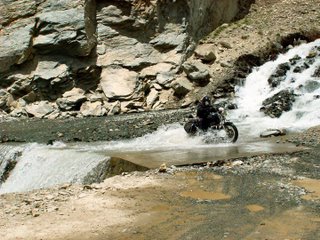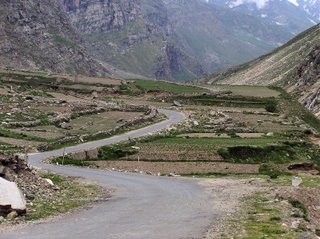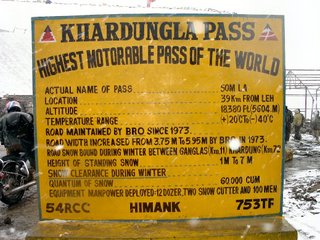The Leh Manual 2
Continued from here
General Notes
Acute Mountain Sickness is a potentially fatal disease, so don't take it lightly. To give you a quick physiological background. The depleted oxygen levels cause the body extreme discomfort. But you knew that. Symptoms:
- Piercing, throbbing, persistent headaches. A number of riders on our trip had these. They seemed not to respond too well to aspirin/paracetamol. The only way to fight them seemed to be to grit your teeth and get on with it. There are cases (I referred to a British medical website) where AMS headaches have caused fatal errors of judgement. You've been warned.
- Nausea This usually follows the headaches and makes the whole situation very nasty, indeed. Again, medicines don't help too much.
- Unconsciousness This is a serious situation. You need to get the patient on oxygen, to a lower altitude or to the nearest army medical camp (Pang is the usual one) for instant and immediate medical attention.
Avoid too much, prolonged physical effort. I'm saying take long breaks, walk slowly and whenever your breath becomes even slightly laboured just stop, sit down and recover. I once needed to take a break while carrying two 1 litre bottles full of water to my tent from the mess tent. The distance was about 45 feet between the two. This was at Sarchu, on the Leh side of the Baralachla. And always, always breath deeply. Sort of like a Baba Ramdev Pranayam.
And eat lots of food. You will be consuming energy at a phenomenal rate, so eat. Ideally, don't drink [alcohol] on the road to Leh. It does not help. This is especially crucial if you already have headaches. There are two medicines which normally help:
- Diamox This takes some time to start working, so hill-experts advice starting to take it three-four days before you hit the altitudes. Please check with your doctor
- Lasix This is the quicker acting one. Warning: Lasix will change your bladder setting to hyperactive. You will want to pee every ten minutes or so. That means, you have to keep drinking to replenish the losses. Also, there isn't much time between feeling like 'I want to go' and wet trousers, so hurry out of the car. The ladies do have a tough time with bodily functions and privacy out in the open, but there really isn't much you can do. The girl with us would basically go around the next corner (and we would not) or climb over to the other side of the nearest hillock.
- More information on AMS: Use the following links
Travel Doctor's guide to Acute Mountain Sickness
ISMM's Non-physician guide to AMS
[The usual disclaimers apply. Please check with your physician/doctor etc before you take any medication whatsoever. No lawsuits, or abuse will be entertained on this count.]
Don't linger on top The top of a mountain pass can be an enthralling place to be. Especially if the weather is good. But don't linger too long. The oxygen levels are really low and it will cause/worsen AMS very fast. While you're there, breathe deeply and fill your lungs. Move slowly, don't yell or shout and get down quickly.
Crossing passes Your worst enemies on the mountains are weather and water. Mountain pass weather is as fickle as a woman's mind. Respect it. Especially Baralachla. That mountain pass is the second out of Manali and the most dangerous in the entire region. It kills the unwary with unfailing regularity every year.
Passes are crossed in the morning for best results. The ideal window is between ten and twelve in the forenoon. After that the weather (whatever is going on) gets worse. At four, the Army will physically close the passes and suspend all rescue activity. You don't want to be stuck on top.
The other reason from crossing between ten and twelve is the water. As the day gets on, the meltwater flows gather strength. A trickle in the morning gurgling across the road in the morning can easily turn into a gushing torrent by the afternoon. Baralachla, once again, has some of the deepest water crossings - at midday they'll wash your axles down. Here are some sites with water crossing tips
- Off-roaders guide to crossing water
- About.com's guide to off-roading|water crossings
- Wheels24.co.za's guide to water crossings
 Crossing water There's a whole bunch of 4x4 enthusiast websites where you can get tips on crossing water. Read them. Always cross at a steady pace, not too fast or slow. And never, ever have two vehicles in the water at the same time. And be ready to have to enter the water to help any stranded vehicles, people. That's anyone. Which means some towels, extra clothes, socks and shoes kept handy.
Crossing water There's a whole bunch of 4x4 enthusiast websites where you can get tips on crossing water. Read them. Always cross at a steady pace, not too fast or slow. And never, ever have two vehicles in the water at the same time. And be ready to have to enter the water to help any stranded vehicles, people. That's anyone. Which means some towels, extra clothes, socks and shoes kept handy. Mountain etiquette Stop to help anyone who seems to be in trouble. Help in any reasonable way you can. And always let bikers pass. Heh heh. Also, sometimes the poor labourers of the BRO will ask for water, or a lift down the road. If you're comfortable, give it to them. They're just homesick Bihari labourers, living in a very hostile place. Wave to them as often as you can.
Mountain etiquette Stop to help anyone who seems to be in trouble. Help in any reasonable way you can. And always let bikers pass. Heh heh. Also, sometimes the poor labourers of the BRO will ask for water, or a lift down the road. If you're comfortable, give it to them. They're just homesick Bihari labourers, living in a very hostile place. Wave to them as often as you can.Night driving is fine up to Chandigarh, after that, I don't really recommend it. Chandigarh-Manali is just too beautiful to waste. And Manali-Leh is just too much of a hazard.
Weather When it gets worse, it gets really, really bad. Carry full rain gear (rain coat etc) ideally not to tight, so you can wear warm stuff underneath. On the mountain tops, rain will usually drag fog and snow into the mix. Drive slow and hope you don't hit black ice.
Food Carry a couple of days food in the car. Maggi type stuff is fine, personally, I prefer Top Ramen or Wai Wai; the wife prefers Maggi. The reason is that when bad weather closes passes or causes landslides, it blocks everything. Your luxury camp can (ours did) run short of supplies, then things can get tense. Closed roads also means hundreds of stuck people, all vying for the same resources. Having your own is an inestimable advantage. Same goes from drinking water.
 Pangong Tso and KhardungLa are both open to Indians, but you need to get a permit. That means a goverment office with days and hours of operation...
Pangong Tso and KhardungLa are both open to Indians, but you need to get a permit. That means a goverment office with days and hours of operation...Continued here





















1 comment:
Thanks! I am about to attempt this next week and this is very good advice.
Cheers,
vince
www.techotek.com
Post a Comment